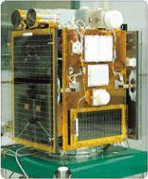닫기
| 인공위성연구센터 소개 | 인공위성관련 정보 | 연구개발 | 인력 양성 | 연구개발시설 | 산업기술지원 | 정보나눔 |
|---|---|---|---|---|---|---|
|
인사말 설립목적과 비전 연혁 조직도 찾아오시는 길 |
인공위성소개 - 인공위성 개요 - 주요 임무 - 내부구조 - 위성체조립 - 환경시험 - 발사 위성개발역사 |
우리별 위성 개발 - 우리별 1호 - 우리별 2호 - 우리별 3호 과학기술위성 개발 - 과학기술위성 1호 - 과학기술위성 2호 - 나로과학위성 - 과학기술위성 3호 차세대 소형위성 개발 초소형위성 군집시스템 개발 핵심우주기술 개발 - 다기능 구조체 - 고성능 탑재컴퓨터 개발 - 홀 추력기용 연료공급장치 - 리튬-이온 배터리 - 초소형 영상 분광기 - 고속데이터 시뮬레이터 과거수행 프로젝트 |
캔위성 체험·경연대회 뉴스페이스 리더 양성 - 사업 개요 - 사업 운영 - FAQ |
지상국 청정실 진동시험기 열진공 챔버 |
환경시험지원 - 진동시험 - 열진공/주기시험 |
공지사항 채용공고 사진자료실 |
| 전체메뉴닫기 | ||||||

Research and Development
STSAT-1
▶ HOME > Research and Development > STSAT Series > STSAT-1

∎ STSAT-1
Launched in September 27, 2003, STSAT-1 was the first Korean astronomical satellite, building on the experience gained through the KITSAT projects to optimize small satellite technology and attempt astronomical observation.STSAT-1 used a stabilized bus system to carry out far-ultraviolet spectrography, space physics, and remote data collection missions to take space environment measurements and explore terrestrial life forms. Using the Far-ultraviolet IMaging Spectrograph (FIMS), jointly developed with NASA, STSAT-1 mapped the distribution of hot gas in the galaxy, revealing key evidence on the evolution of the galaxy.
The successful launch and operation of STSAT-1 holds great meaning as it demonstrated the ability to carry out scientific missions on a small satellite and yielded world-class observation data.
- To carry out world-class scientific observation using a small satellite
- To develop and test leading core technologies
- To observe space and earth through far-ultraviolet imaging spectrography
- To conduct particle detection experiments to investigate the auroral mechanism
| Orbit | 690 km circular Sun-synchronous Orbit |
| Size | 665x551x830 mm |
| Weight | 106 kg |
| Power Rating | Max. 180 W |
| Attitude Control Method | 3-axis stabilization, < 0.2 deg pointing accuracy |
| Communication (Transfer Speed) |
VHF-band Uplink (148 MHz frequency band) : 9600bps UHF-band Downlink (401 MHz frequency band) : 9600bps S-band Uplink: 9600bps S-band Downlink: 38400bps |
| Main Computer | KASCOM(80960) |
| Payloads |
Far-ultraviolet IMaging Spectrograph(FIMS) Space Physics Package(SPP) - Solid-State Telescope(SST) - Electro-Static Analyzer(ESA) - Langmuir Probe(LP) - Scientific Magnetometer(SM) Data Collection System(DCS) Narrow Angle Star Sensor(NAST) |


